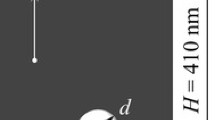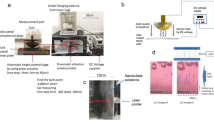Abstract
The size of the bulk nanobubbles (typically 100 nm-200 nm in diameter) is below the optical resolution of the typical microscopes, which makes it difficult to make a direct observation of them and differentiate between the nanoparticles and the nanobubbles. In this work, a nanoparticle tracking analysis (NTA) system is developed for tracking and sizing the bulk nanobubbles, and more broadly, the Brownian diffusing particles. We demonstrate the capabilities of the NTA in characterizing the nanoparticles through systematic validation of accuracy and resolution. We particularly exhibit its unique advantages in detecting the polydisperse nanoparticle populations. Then the nucleation and the thermodynamic stability of the bulk nanobubbles are systematically studied by the NTA system. The bulk nanobubbles smaller than 600 nm in size are generated via the ultrasonication method. It is shown that both the ultrasonic cavitation treatment time and amplitude, essentially, the energy input, favor the nucleation of the bulk nanobubbles with a more concentrated size distribution, a higher concentration, and a smaller hydrodynamic size. The temperature dependence of the bulk nanobubbles over a wide range from 25°C to 70°C is explored. It is found that the nanobubble first shrinks in size significantly and then the size keeps approximately constant with the increasing temperature, showing a narrow size distribution. The transition temperature is around 45°C. Further, as an open system, the NTA is a potential tool in the study of the dynamic behavior of the bulk nanobubbles in situ, such as the coalescence and the collapse.
Similar content being viewed by others
References
Tan B. H., An H., Ohl C. D. Stability of surface and bulk nanobubbles [J]. Current Opinion in Colloid and Interface Science, 2021, 53: 101428.
Favvas E. P., Kyzas G. Z., Efthimiadou E. K. et al. Bulk nanobubbles, generation methods and potential applications [J]. Current Opinion in Colloid and Interface Science, 2021, 54: 101455.
Zhang F., Sun L., Yang H. et al. Recent advances for understanding the role of nanobubbles in particles flotation [J]. Advances in Colloid and Interface Science, 2021, 291: 102403.
Gao Y., Li M., Sun C. et al. Microbubble-enhanced water activation by cold plasma [J]. Chemical Engineering Journal, 2022, 446: 137318.
Epstein P. S., Plesset M. S. On the stability of gas bubbles in liquid-gas solutions [J]. The Journal of Chemical Physics, 1950, 18(11): 1505–1509.
Nirmalkar N., Pacek A. W., Barigou M. Bulk nanobubbles from acoustically cavitated aqueous organic solvent mixtures [J]. Langmuir, 2019, 35(6): 2188–2195.
Nirmalkar N., Pacek A. W., Barigou M. On the existence and stability of bulk nanobubbles [J]. Langmuir, 2018, 34(37): 10964–10973.
Tan B. H., An H., Ohl C. D. Identifying surface-attached nanobubbles [J]. Current Opinion in Colloid and Interface Science, 2021, 53: 101429.
Lohse D., Zhang X. Pinning and gas oversaturation imply stable single surface nanobubbles [J]. Physical Review E, 2015, 91(3): 031003.
Lohse D., Zhang X. Surface nanobubbles and nanodroplets [J]. Reviews of Modern physics, 2015, 87(3): 981.
Wang Q., Zhao H., Qi N. et al. Generation and stability of size-adjustable bulk nanobubbles based on periodic pressure change [J]. Scientific reports, 2019, 9(1): 1–9.
Sugano K., Miyoshi Y., Inazato S. Study of ultrafine bubble stabilization by organic material adhesion [J]. Japanese Journal of Multiphase Flow, 2017, 31(3): 299–306.
Eklund F., Alheshibri M., Swenson J. Differentiating bulk nanobubbles from nanodroplets and nanoparticles [J]. Current Opinion in Colloid and Interface Science, 2021, 53: 101427.
Bunkin N. F., Shkirin A. V., Ignatiev P. S. et al. Nanobubble clusters of dissolved gas in aqueous solutions of electrolyte. I. Experimental proof [J]. The Journal of chemical physics, 2012, 137(5): 054706.
Alheshibri M., Craig V. S. J. Differentiating between nanoparticles and nanobubbles by evaluation of the compressibility and density of nanoparticles [J]. The Journal of Physical Chemistry C, 2018, 122(38): 21998–22007.
Oh S. H., Kim J. M. Generation and stability of bulk nanobubbles [J]. Langmuir, 2017, 33(15): 3818–3823.
Uchida T., Yamazaki K., Gohara K. Generation of micro- and nano-bubbles in water by dissociation of gas hydrates [J]. Korean Journal of Chemical Engineering, 2016, 33(5): 1749–1755.
Filipe V., Hawe A., Jiskoot W. Critical evaluation of nanoparticle tracking analysis (NTA) by NanoSight for the measurement of nanoparticles and protein aggregates [J]. Pharmaceutical research, 2010, 27(5): 796–810.
Gallego-Urrea J. A., Tuoriniemi J., Hassellöv M. Applications of particle-tracking analysis to the determination of size distributions and concentrations of nanoparticles in environmental, biological and food samples [J]. TrAC Trends in Analytical Chemistry, 2011, 30(3): 473–483.
Van Der Pol E., Coumans F. A. W., Sturk A. et al. Refractive index determination of nanoparticles in suspension using nanoparticle tracking analysis [J]. Nano letters, 2014, 14(11): 6195–6201.
Malloy A., Carr B. Nanoparticle tracking analysis-The halo™ system [J]. Particle and Particle Systems Characterization, 2006, 23(2): 197–204.
Walker J. G. Improved nano-particle tracking analysis [J]. Measurement Science and Technology, 2012, 23(6): 065605.
Wagner T., Lipinski H. G., Wiemann M. Dark field nanoparticle tracking analysis for size characterization of plasmonic and non-plasmonic particles [J]. Journal of Nanoparticle research, 2014, 16(5): 2419.
Li M., Ma X., Eisener J. et al. How bulk nanobubbles are stable over a wide range of temperatures [J]. Journal of Colloid and Interface Science, 2021, 596: 184–198.
Ma X., Li M., Pfeiffer P. et al. Ion adsorption stabilizes bulk nanobubbles [J]. Journal of Colloid and Interface Science, 2022, 606: 1380–1394.
Brennen C. E. Cavitation and bubble dynamics [M]. Cambridge, UK: Cambridge University Press, 2014.
Kim J. Y., Song M. G., Kim J. D. Zeta potential of nanobubbles generated by ultrasonication in aqueous alkyl polyglycoside solutions [J]. Journal of Colloid and Interface Science, 2000, 223(2): 285–291.
Ghaani M. R., Kusalik P. G., English N. J. Massive generation of metastable bulk nanobubbles in water by external electric fields [J]. Science advances, 2020, 6(14): eaaz0094.
Author information
Authors and Affiliations
Corresponding author
Ethics declarations
This article does not contain any studies with human participants or animals performed by any of the authors.
Additional information
Conflict of Interest
The authors declare that they have no conflict of interest.
Compliance with Ethical Standards
Conflict of Interest: Informed consent was obtained from all individual participants included in the study.
Project supported by the National Natural Science Foundation of China (Grant Nos. 11988102, 91852202), the Tencent Foundation through the XPLORER PRIZE.
Biography: **ao-tong Ma (1996-), Female, Ph. D. Candidate
Rights and permissions
About this article
Cite this article
Ma, Xt., Li, Mb. & Sun, C. Measurement and characterization of bulk nanobubbles by nanoparticle tracking analysis method. J Hydrodyn 34, 1121–1133 (2022). https://doi.org/10.1007/s42241-022-0077-5
Received:
Revised:
Accepted:
Published:
Issue Date:
DOI: https://doi.org/10.1007/s42241-022-0077-5




